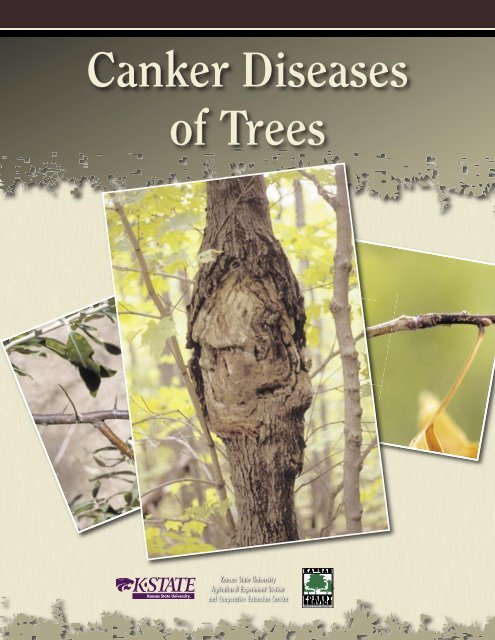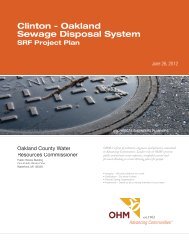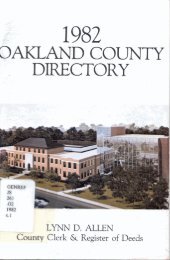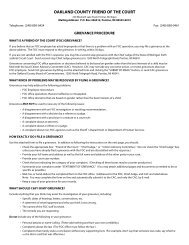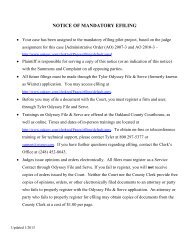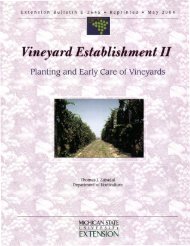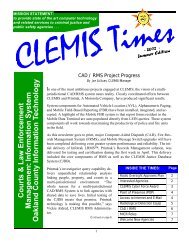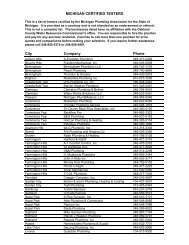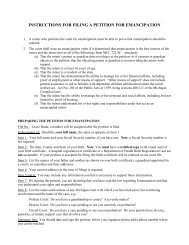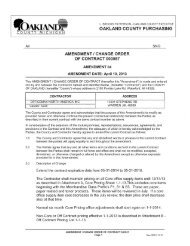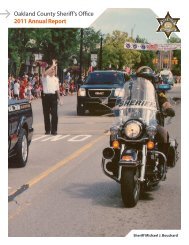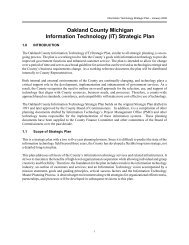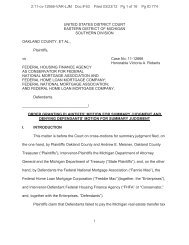MF2658 Canker Diseases of Trees - Kansas State University
MF2658 Canker Diseases of Trees - Kansas State University
MF2658 Canker Diseases of Trees - Kansas State University
Create successful ePaper yourself
Turn your PDF publications into a flip-book with our unique Google optimized e-Paper software.
<strong>Canker</strong> <strong>Diseases</strong><br />
<strong>of</strong> <strong>Trees</strong><br />
<strong>Kansas</strong> <strong>State</strong> <strong>University</strong><br />
Agricultural Experiment Station<br />
and Cooperative Extension Service
Some cankers may develop at the base <strong>of</strong> the trunk. Photo courtesy M. Drilias.<br />
<strong>Canker</strong>s are localized dead areas <strong>of</strong><br />
bark in trees and shrubs caused<br />
by fungi and bacterial infection.<br />
<strong>Canker</strong> pathogens can cause annual<br />
branch and twig dieback, disfiguring<br />
perennial stem cankers, or large,<br />
diffuse trunk cankers capable <strong>of</strong> killing<br />
trees in a short time. <strong>Canker</strong> pathogens<br />
cause some <strong>of</strong> the most destructive tree<br />
diseases, including chestnut blight,<br />
butternut (white walnut) canker, and<br />
dogwood anthracnose.<br />
Bark and <strong>Canker</strong> Formation<br />
Bark is composed <strong>of</strong> layers <strong>of</strong> tissues<br />
that surround the woody core <strong>of</strong> the<br />
trunk or branch. The outermost layer <strong>of</strong><br />
bark consists <strong>of</strong> corky, dead plant cells.<br />
Outer bark surface reduces water loss<br />
and serves as a physical barrier that<br />
protects inner bark tissue and sapwood.<br />
Outer bark effectively prevents the<br />
entrance <strong>of</strong> most canker pathogens.<br />
Instead, these organisms usually enter<br />
and infect bark through wounds,<br />
including broken twigs or branches,<br />
pruning cuts, mower damage, insect<br />
injury, and hail damage. It can also<br />
enter through leaf scars, or small,<br />
natural bark openings called lenticels.<br />
Injured bark may be susceptible<br />
to infection for only a short period<br />
following wounding because <strong>of</strong> physical<br />
and chemical changes that occur to<br />
suppress pathogen development.<br />
Once canker pathogens breach the<br />
outer bark barrier, they may then<br />
colonize other bark tissue. This process<br />
can reduce tree vigor, weaken the<br />
wood at the infection site, enhance the<br />
possibility <strong>of</strong> wood decay, and ultimately<br />
result in branch or trunk breakage and<br />
tree mortality.<br />
Inner bark, or that closest to the<br />
sapwood, contains a thin, living layer<br />
<strong>of</strong> tissue called the phloem. Sugars<br />
manufactured in leaves during<br />
photosynthesis move to the roots and<br />
other areas <strong>of</strong> the tree through the<br />
phloem. <strong>Canker</strong> pathogens can kill the<br />
phloem, disrupt nutrient movement,<br />
and starve portions <strong>of</strong> the tree.<br />
Another thin, but vital layer <strong>of</strong> tissue<br />
called the vascular cambium lies just<br />
inside the phloem. Each growing<br />
season, plant cells derived from the<br />
cambium differentiate to form new<br />
phloem to the outside <strong>of</strong> the trunk<br />
cylinder, and sapwood, responsible<br />
for water movement, to the inside.<br />
Addition <strong>of</strong> new sapwood each year<br />
results in an increase in branch or<br />
trunk diameter. <strong>Canker</strong> pathogens that<br />
damage the vascular cambium impair
water and nutrient movement and<br />
may reduce stem diameter growth in<br />
affected areas. Some canker pathogens<br />
are capable <strong>of</strong> colonizing and degrading<br />
the wood (called canker rots), but most<br />
do not invade sapwood or do so only to<br />
a limited extent.<br />
Symptoms<br />
<strong>Canker</strong> symptoms vary depending on<br />
the pathogen and tree species. <strong>Canker</strong>s<br />
on thin-barked trees <strong>of</strong>ten appear<br />
as sharply defined, slightly sunken,<br />
depressed areas. Healthy bark tissue<br />
outside the canker is light in color<br />
whereas cankered tissue is discolored<br />
shades <strong>of</strong> red, brown, or black. Diseased<br />
bark can be water-soaked, resinous, or<br />
exude a foul-smelling sap. <strong>Canker</strong>s on<br />
thick or rough-barked trees are more<br />
difficult to detect and can be viewed by<br />
carefully shaving <strong>of</strong>f the outer bark with<br />
a knife. <strong>Canker</strong>s <strong>of</strong>ten are elongated,<br />
because canker pathogens tend to<br />
colonize the bark more rapidly up and<br />
down the stem. <strong>Canker</strong> pathogens<br />
sometimes form spore-bearing fruiting<br />
structures on the surface <strong>of</strong> dead bark.<br />
These structures are useful in pathogen<br />
identification and range from minute<br />
black pepper-like spots to small bright<br />
red, coral-like clusters.<br />
1 year resulting in perennial cankers.<br />
On certain trees, a distinctive perennial<br />
target canker develops as the pathogen<br />
slowly colonizes rings <strong>of</strong> callus<br />
formed each spring to prevent canker<br />
enlargement.<br />
<strong>Canker</strong>s may be more numerous<br />
and serious on trees suffering<br />
environmental stresses (freeze or<br />
drought injury). Increases in cankerrelated<br />
tree problems are common<br />
during extended periods <strong>of</strong> drought<br />
or following sudden temperature<br />
fluctuations. Tissue damaged by<br />
early-fall or late-spring freezes, or<br />
by extreme winter temperatures are<br />
quickly colonized by canker pathogens.<br />
Drought stress can impair the plant’s<br />
ability to defend against fungal<br />
invasion. Conversely, excessive watering<br />
can kill roots and predispose plants<br />
to canker pathogens. Other factors<br />
that contribute to canker formation<br />
include root injury from construction,<br />
transplant shock, or herbicide damage.<br />
Some tree species are especially<br />
prone to canker development. These<br />
include certain willow (Salix spp.)<br />
species and their hybrids; hybrids<br />
<strong>of</strong> eastern cottonwood (Populus<br />
deltoides); Siberian elm (Ulmus<br />
pumila); honeylocust (Gledetsia<br />
triacanthos); certain species <strong>of</strong> plum,<br />
cherry, and peach (Prunus spp.<br />
especially P. cerasifera and P. persica);<br />
Russian olive (Eleagnus angustifolia);<br />
Rocky Mountain juniper (Juniperus<br />
scopulorum); and ornamental cultivars<br />
<strong>of</strong> white and red mulberry (Morus<br />
rubra and M. alba).<br />
Leucostoma and Valsa<br />
(Cytospora) <strong>Canker</strong>s<br />
The fungi Leucostoma and Valsa cause<br />
canker diseases on species including<br />
maples (Acer spp.), plums and peach<br />
(Prunus spp.), poplar and cottonwood<br />
(Populus spp.), willow (Salix spp.)<br />
elm (Ulmus spp.), and spruce (Picea<br />
Twig canker developing after infection <strong>of</strong> leaf scar. Note the black discoloration<br />
<strong>of</strong> diseased bark.<br />
<strong>Canker</strong> development also is variable.<br />
Some canker pathogens are only<br />
capable <strong>of</strong> colonizing bark during a<br />
relatively short period when woody<br />
plants are not actively growing (e.g.<br />
late fall through early spring). These<br />
annual cankers do not expand after<br />
plant growth resumes in spring<br />
because the tree produces chemicals<br />
and new tissues, including a defensive<br />
tissue layer called callus, which<br />
prevents further pathogen colonization.<br />
Annual cankers <strong>of</strong>ten are associated<br />
with branch and twig dieback initiated<br />
by temperature or moisture stresses.<br />
Diffuse cankers result when pathogens<br />
colonize the bark so rapidly the tree<br />
cannot develop adequate defensive<br />
barriers. These cankers may quickly<br />
girdle the trunk and kill the tree.<br />
Some pathogens are able to persist<br />
and colonize bark tissue for more than
Bark has been removed from this trunk to show multiple, diffuse cankers.<br />
spp.). <strong>Diseases</strong> caused by these fungi<br />
are also called Cytospora cankers<br />
(Cytospora refers to the Latin name<br />
<strong>of</strong> the asexual stages <strong>of</strong> these fungi).<br />
Cytospora cankers usually are found on<br />
trees that have been damaged by cold<br />
temperatures or drought.<br />
Cytospora or perennial cankers <strong>of</strong><br />
peach and plum (Prunus spp.) caused<br />
by L. persooni and L. cinctum are some<br />
<strong>of</strong> the most widespread and destructive<br />
peach and ornamental plum diseases.<br />
These diseases can cause gradual<br />
twig and branch mortality, or can<br />
result in rapid tree death. In healthy<br />
trees, fungal colonization is restricted<br />
to injured tissue and results in<br />
the formation <strong>of</strong> sunken cankers.<br />
Fungal colonization is more rapid<br />
and expansive in trees weakened by<br />
drought or freeze damage and can<br />
progress down twigs and into scaffold<br />
limbs where large, diffuse cankers are<br />
formed. Diseased sapwood beneath the<br />
canker turns reddish-brown. Small<br />
black pinpoint fruiting structures<br />
called pycnidia form in dead bark and<br />
exude brightly colored spore tendrils<br />
during wet weather. The spores are<br />
dispersed by splashing rain and insects.<br />
<strong>Canker</strong> surfaces can be covered with a<br />
gummy, resin-like coating, although<br />
this is not necessarily diagnostic since<br />
other diseases and environmental<br />
factors cause bleeding.<br />
Valsa (Cytospora) canker <strong>of</strong> poplars<br />
and willows is caused by the fungus<br />
Valsa sordida. This widespread canker<br />
disease is almost always associated<br />
with drought and/or cold temperature<br />
damage and causes annual twig and<br />
branch dieback or slowly expanding<br />
perennial cankers that are similar<br />
in appearance to those caused by<br />
L. persooni and L. cincta on Prunus<br />
species. Trunk cankers can be irregular<br />
in shape and difficult to see. During<br />
wet weather bright orange spore<br />
masses up to ½ inch in length exude<br />
from the fruiting bodies embedded in<br />
the canker.<br />
Leucostoma (Cytospora) canker <strong>of</strong><br />
Colorado blue spruce (Picea pungens)<br />
first appears in the lower portion <strong>of</strong><br />
the tree crown. Needles on diseased<br />
branches turn purple or brown and<br />
drop prematurely. Branch cankers<br />
commonly develop near the junction<br />
with the main trunk and <strong>of</strong>ten are<br />
covered with a white pitch that<br />
drips onto adjacent branches. Wood<br />
beneath the cankered bark is resinimpregnated<br />
and dark blue-brown.<br />
Occasionally, small, black fruiting<br />
structures (pycnidia) <strong>of</strong> the fungus<br />
can be seen in diseased bark, but they<br />
<strong>of</strong>ten are difficult to find because <strong>of</strong><br />
the abundant pitch. Multiple branch<br />
cankers can result in mortality <strong>of</strong> most<br />
lower branches on a tree.<br />
Nectria <strong>Canker</strong>s<br />
Nectria cinnabarina, also known<br />
as the coral spot fungus, is an<br />
opportunistic pathogen tree species<br />
including apple, ash (Aesculus),<br />
birch (Betula), goldenraintree<br />
(Koelreuteria paniculata), honeylocust<br />
(Gledetsia triacanthos), maple (Acer),<br />
mulberry(Morus), and oak (Quercus).<br />
The fungus causes annual cankers<br />
that usually devlop near branch<br />
tips weakened by drought or freeze<br />
damage. Dieback rarely extends into<br />
larger branches or the trunk except on<br />
severely weakened trees. Distinctive<br />
coral pink fruiting structures<br />
(sporodochia) <strong>of</strong> the fungus are<br />
common on dead bark.<br />
Nectria austroamericana, (also called<br />
Thyronectria austroamericana) causes<br />
a widespread and serious disease <strong>of</strong><br />
honeylocust called Thyronectria canker.<br />
<strong>Canker</strong>s are found on all aboveground<br />
woody plant parts but are particularly<br />
common at branch stubs, pruning<br />
wounds, and on bark damaged by<br />
sunburn.<br />
<strong>Canker</strong>s initially are elliptical, slightly<br />
depressed and reddish-orange. Sapwood<br />
just beneath the canker is also stained<br />
red. A reddish brown liquid may drip<br />
from the canker and stain the outer<br />
bark. With time, dead outer bark<br />
bleaches light tan, develops cracks, and<br />
Discolored inner bark associated<br />
with branch and trunk cankers.
egins to slough from the tree. Small<br />
clusters <strong>of</strong> red to pink fungal fruiting<br />
structures (pycnidia), eventually<br />
turning black with age, form in lenticels<br />
scattered throughout the dead bark. A<br />
second, light brown fruiting structure<br />
(perithecium) can form in older<br />
cankers. <strong>Canker</strong>s on rough-barked<br />
trunks or branches are obscure and<br />
can only be detected when bark begins<br />
to slough or fungal fruiting structures<br />
appear. <strong>Canker</strong>ed trees exhibit lightcolored<br />
foliage, branch dieback, and<br />
poor growth. Girdling trunk cankers<br />
can kill trees.<br />
Honeylocust cultivars vary in<br />
susceptibility to Thyronectria canker.<br />
Research in Colorado indicates<br />
Sunburst is most susceptible, Moraine<br />
and Skyline intermediate, and Imperial,<br />
Holka, and Shade Master the most<br />
resistant.<br />
Nectria galligena causes branch<br />
and trunk cankers similar to those<br />
<strong>of</strong> N. cinnabarina on a number <strong>of</strong><br />
species. These cankers <strong>of</strong>ten are<br />
annual and are associated with poor<br />
growing conditions. However, large,<br />
perennial target-shaped cankers caused<br />
by N. galligena form on certain tree<br />
species.<br />
Perennial canker <strong>of</strong> peach. Note gummy resin leaking from canker.<br />
Botryosphaeria <strong>Canker</strong>s<br />
Several species <strong>of</strong> Botryosphaeria cause<br />
cankers on trees and other woody<br />
ornamentals. These fungi survive as<br />
saprophytes on bark killed by natural<br />
causes or by other plant pathogens<br />
or insects. They are opportunistic<br />
pathogens and quickly colonize bark<br />
injured by drought, freeze, or sunscald.<br />
<strong>Canker</strong>s tend to be annual and ranged<br />
in size from small elongated spots<br />
restricted to the outer bark, to larger,<br />
more diffuse lesions on seriously<br />
damaged trunks and branches.<br />
B. stevensii causes elongated, flattened,<br />
<strong>of</strong>ten resinous cankers on Rocky<br />
Mountain juniper (J. scopulorum),<br />
savin juniper (J. sabina), and<br />
occasionally eastern redcedar<br />
(J. virginiana). <strong>Canker</strong>s can occur
(left) Branch dieback <strong>of</strong> goldenraintree<br />
associated with winter injury and<br />
Nectria cankers.<br />
(below left) Valsa canker <strong>of</strong> poplar.<br />
Spores <strong>of</strong> the fungus are exuded from<br />
cankers in bright orange tendrils<br />
during rainy weather.<br />
(below) Thyronectria canker<br />
<strong>of</strong> honeylocust.
anywhere on woody stems, but are<br />
more common near branch crotches.<br />
Girdling stem cankers can cause rapid<br />
death <strong>of</strong> individual branches or the top<br />
portion <strong>of</strong> the tree crown. Small black<br />
fruiting bodies develop in the canker,<br />
but these may be partially hidden by<br />
thin pieces <strong>of</strong> dead bark.<br />
B. dothidea is a common canker<br />
pathogen <strong>of</strong> flowering crabapple,<br />
ash, rhododendrons, and many other<br />
decidous trees and shrubs. The disease<br />
occasionally causes branch and trunk<br />
cankers on eastern white pine, Douglas<br />
fir, and true firs. <strong>Canker</strong>s are similar to<br />
those described for B. stevensii.<br />
Phomopsis <strong>Canker</strong><br />
<strong>of</strong> Russian Olive<br />
The fungus Phomopsis arnoldiae is<br />
responsible for a canker disease <strong>of</strong><br />
Russian olive (Eleagnus angustifolia).<br />
<strong>Canker</strong>s on small branches are reddishbrown<br />
to black with sunken margins.<br />
Sapwood beneath diseased bark is<br />
discolored brown or black. Small black<br />
fruiting structures <strong>of</strong> the fungus dot<br />
the diseased bark tissue. <strong>Canker</strong>s on<br />
Botryosphaeria canker is lethal to<br />
Rocky Mountain juniper in eastern<br />
<strong>Kansas</strong>.<br />
larger branches are slightly sunken,<br />
rougher in texture, and may exhibit<br />
gummosis and bleeding. Girdling<br />
cankers restrict water movement and<br />
cause rapid wilting <strong>of</strong> foliage. Leaves<br />
on affected branches turn light-tan<br />
and become brittle, but usually remain<br />
attached to the tree. Multiple branch<br />
cankering over a period <strong>of</strong> several years<br />
results in branch dieback and a general<br />
tree decline.<br />
<strong>Canker</strong> Management<br />
Prevention is the key to management<br />
<strong>of</strong> canker diseases. <strong>Canker</strong> pathogens<br />
can be difficult to eradicate once<br />
the infection process has started.<br />
Avoid planting trees species that are<br />
genetically susceptible to cankers<br />
(e.g. flowering plums) or species that<br />
are predisposed to cankers because <strong>of</strong><br />
lack <strong>of</strong> winter hardiness or drought<br />
tolerance. Optimize conditions for tree<br />
growth and minimize environmental<br />
stresses that predispose trees to<br />
cankers. This is especially important<br />
on newly transplanted trees since they<br />
are vulnerable to cankers. Protect<br />
young, thin-barked trees from sunburn<br />
damage to the trunk by proper use<br />
<strong>of</strong> tree wraps. Maintain soil moisture<br />
throughout the season by the use <strong>of</strong><br />
organic mulches and timely watering,<br />
but do not overwater. Fertilization<br />
maintains tree vitality, but excessive<br />
fertilization can result in succulent<br />
growth that is more prone to insect and<br />
pathogen damage.<br />
Minimize wounding <strong>of</strong> tree bark<br />
caused by careless mowing practices<br />
or unnecessary pruning. If pruning<br />
is required, make cuts flush with the<br />
branch collar located at the base <strong>of</strong> the<br />
branch. Do not cut branches flush with<br />
the trunk or leave branch stubs. Avoid<br />
pruning during wet weather. Most<br />
commercial tree wound dressings do<br />
not contain fungicides, have not been<br />
shown to prevent canker formation,<br />
and should not be used to treat fresh<br />
pruning cuts. Limited university<br />
research has shown that treating<br />
fresh pruning cuts with a fungicide<br />
may help reduce canker development<br />
Botryosphaeria dothidea may cause<br />
trunk damage and bark sloughing to<br />
flowering crabapple and other trees<br />
following drought injury.<br />
on fruit trees, but this practice is <strong>of</strong><br />
questionable value for trees in the<br />
landscape.<br />
Remove branch cankers by pruning at<br />
least 2 to 3 inches below the canker<br />
margin. Make sure to prune at a branch<br />
crotch so as not to leave branch stubs.<br />
<strong>Canker</strong> removal will improve tree<br />
appearance, but will not necessarily<br />
eliminate future canker development.<br />
<strong>Canker</strong> development is usually more<br />
dependent on tree health rather than<br />
reduction <strong>of</strong> pathogen inoculum.<br />
Trunk cankers are more difficult to<br />
control. As a general guideline, remove<br />
the tree if a perennial trunk canker has<br />
damaged more than one third <strong>of</strong> the<br />
trunk circumference. It is unlikely the<br />
tree will recover. On the other hand,<br />
trees with inactive trunk cankers <strong>of</strong>ten<br />
fully recover. The presence <strong>of</strong> a slight
swelling <strong>of</strong> light-colored callus tissue<br />
around the canker perimeter may<br />
indicate successful containment <strong>of</strong><br />
the pathogen. Carefully remove, dead<br />
sloughing bark from the canker face,<br />
but be careful not to damage the callus<br />
tissue surrounding the canker. Do not<br />
attempt to chisel or scrape away dead<br />
tissue from the center <strong>of</strong> the canker.<br />
Carefully scribing 1 to 2 inches<br />
outside the canker margin with a<br />
knife, then discarding all diseased<br />
bark tissue can remove some small<br />
trunk cankers. However, this process<br />
leaves a very large wound and may<br />
damage healthy tissue. In many cases,<br />
a healthy, vigorous tree likely will seal<br />
<strong>of</strong>f the cankered areas naturally and<br />
no intervention is necessary. Only<br />
skilled arborists should attempt canker<br />
removal.<br />
Branch tip dieback on oak<br />
caused by Botryosphaeria.<br />
Damage is usually<br />
restricted to the terminal<br />
6 inches <strong>of</strong> the branch.<br />
Phomosis canker on<br />
Russian olive is dark<br />
brown to black and <strong>of</strong>ten<br />
starts at the base <strong>of</strong> dead<br />
twigs (center).<br />
This publication is made available in<br />
cooperation with the USDA Forest Service.<br />
Ned A. Tisserat<br />
Plant Pathologist<br />
Brand names appearing in this publication are for product identification purposes only. No endorsement is intended,<br />
nor is criticism implied <strong>of</strong> sim i lar products not mentioned.<br />
Publications from <strong>Kansas</strong> <strong>State</strong> <strong>University</strong> are available on the World Wide Web at: www.oznet.ksu.edu<br />
Contents <strong>of</strong> this publication may be freely reproduced for educational purposes. All other rights reserved. In each case, credit<br />
Ned A. Tisserat, <strong>Canker</strong> <strong>Diseases</strong> <strong>of</strong> <strong>Trees</strong>, Kan sas <strong>State</strong> Uni ver si ty, October 2004.<br />
<strong>Kansas</strong> <strong>State</strong> <strong>University</strong> Agricultural Experiment Station and Co op er a tive Ex ten sion Ser vice<br />
MF-2658 October 2004<br />
K-<strong>State</strong> Research and Extension is an equal opportunity provider and employer. Issued in furtherance <strong>of</strong> Co op er a tive Extension Work, Acts <strong>of</strong> May 8 and June 30, 1914,<br />
as amended. <strong>Kansas</strong> <strong>State</strong> Uni ver si ty, County Ex ten sion Councils, Extension Districts, and United <strong>State</strong>s De part ment <strong>of</strong> Ag ri cul ture Cooperating, Fred A. Cholick, Director.


